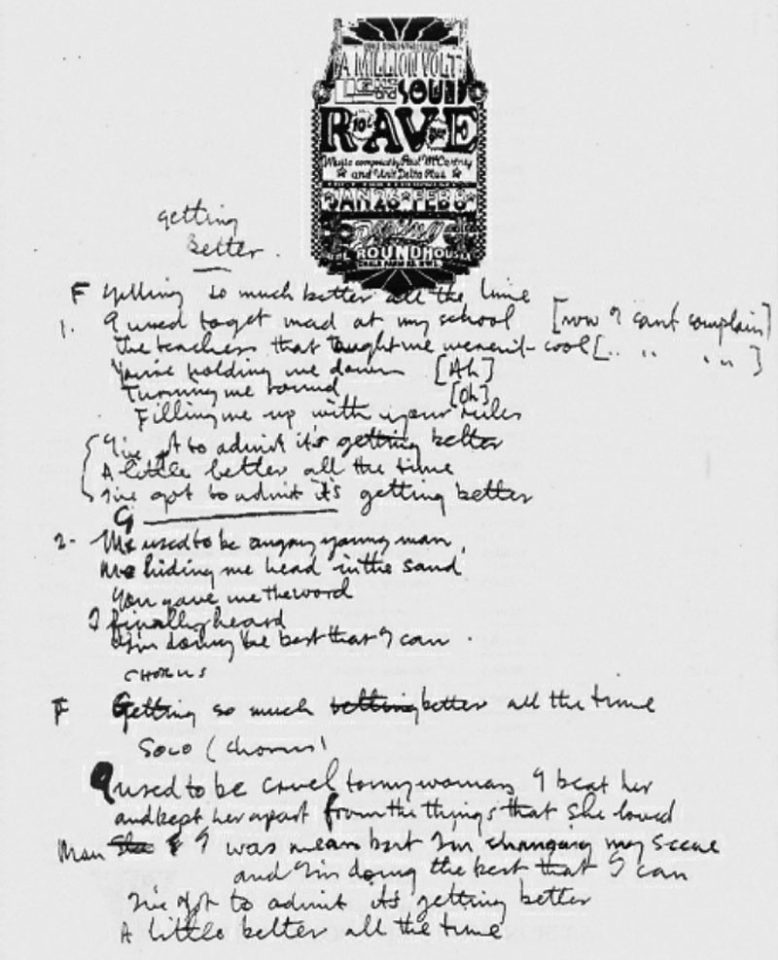Inspelning, mixning och editering av ’Getting Better’ och ’Lovely Rita’
Man skapade två reduktionsmixningar numrerade 13 och 14 för att få mer utrymme på bandet som hade fyra kanaler. Dessa mixningar innebar att man la rytmspåret från den 9 mars samt tamburaspelet på spår ett och basgitarren och trummornas överdubbningar på spår två.
Hunter Davies berättar:
George Harrison and Ivan [Vaughan] went off to chat in a corner, but Paul and John listened carefully. Paul instructed the technician on which levers to press, telling him what he wanted, how it should be done, which bits he liked best. George Martin looked on, giving advice where necessary. John stared into space…
They played the backing track of ‘It’s Getting Better’ [sic] for what seemed like the hundredth time, but Paul said he wasn’t happy about it. They’d better get Ringo in and they would do it all again. Someone went to ring for Ringo.
Peter Brown arrived… They played him the backing track of It’s Getting Better. As it was being played, Paul talked to one of the technicians and told him to try yet a different sound mix. He did so and Paul said that was much better. It would do. They didn’t need to bring Ringo in now after all.
‘And we’ve just ordered Ringo on toast,’ said John. But Ringo was cancelled in time and the studio was got ready to record the sound track, the voices… The three of them held their heads round one microphone and sang It’s Getting Better while up in the control box, George Martin and his two assistants got it all down on track. The three Beatles were singing, not playing, but through the headphones strapped to their ears they could hear the recording of the backing track. They were simply singing to their already recorded accompaniment.
In the studio itself, all that could be heard were the unaccompanied, un-electrified voices of the Beatles singing, without any backing. It all sounded flat and out of key.
Sången spelades in på nytt, med bättre resultat den 23 mars 1967. The Beatles inblandning i denna sessionen närmade sig slutet, då John Lennon började känna effekterna av en LSD-tablett som han hade tagit av misstag.
A man in a purple shirt called Norman arrived. He used to be one of their recording engineers and now had a group of his own, The Pink Floyd. Very politely he asked George Martin if his boys could possibly pop in to see the Beatles at work. George smiled, unhelpfully. Norman said perhaps he should ask John personally, as a favour. George Martin said no, that wouldn’t work. But if by chance he and his boys popped in about eleven o’clock, he might just be able to see what he could do.
They did pop in, around eleven, and exchanged a few half-hearted hellos. The Beatles were still going through the singing of It’s Getting Better, for what now seemed like the thousandth time. By two o’clock they’d got it at least to a stage which didn’t make them unhappy.
När det stod klart för alla att John Lennon inte längre hade möjlighet att fortsätta kvällens arbete, körde Paul McCartney och Mal Evans John till Cavendish Avenue nr 7, McCartneys hus, vilket låg bara en kort väg från EMI Studios.
I studion på Abbey Road, spelade George Martin in pianosolot till Lovely Rita. Detta innebar att man saktade ner bandspelarens hastighet från 50 cykler per sekund till 41 1/4 cykler per sekund, vilket innebar att solot lät mycket snabbare när det sedan spelades upp i normal hastighet.
Geoff Emerick berättar:
I used to try out funny things in odd moments and I discovered that by putting sticky tape over the capstan of a tape machine you could wobble the tape on the echo machine, because we used to delay the feed into the echo chamber by tape. So I suggested we did this using a piano sound. The Beatles themselves couldn’t think what should go into the song’s middle eight and they didn’t really like my idea at first, but it turned out fine in the end because of the effect. It gave the piano a sort of honky-tonk feel. In fact, Paul asked me to play the solo when I made the suggestion but I was too embarrassed.
När väl Lovely Rita var klar skapade man en monomixning av låten. Detta gjordes genom att man lät bandspelaren gå med 48 3/4 cykler per sekund vilket innebar att låten hamnade när tonareten E-dur. song in the region of E-flat major. Deet kan vara intressant att veta att bakgrundsspåren med basgitarr, sång och piano alla hade spelats in i olika tonarter!
Det behövdes hela 15 försök att skapa en tillfredsställande monomixning, där nummer 11 och 14 ansågs vara de bästa. Dessa editerades senare ihop under denna händelserika session. Arbetet med Lovely Rita var därmed slutfört. Nu saknades bara stereomixningar, vilka skapades den 17 april 1967..

